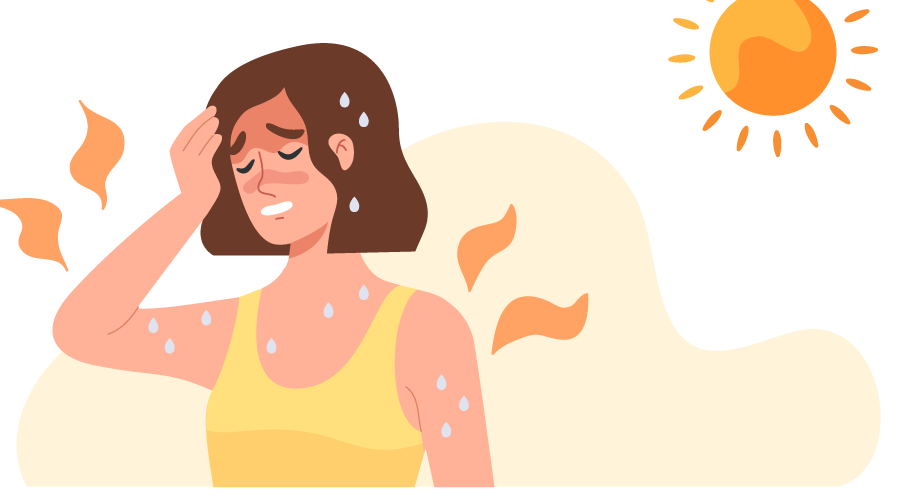

As the name suggests, heat stroke is a serious heat-related illness that is caused when the human body is not able to control its temperature. In such a situation, the body’s temperature rises rapidly, the sweating mechanism fails, and the body is unable to cool down. A heat illness is generally caused when the weather is hot. Other than high temperatures, there are several factors, which result in heat illness. These factors are – dehydration, physical exertion, old age, chronic disease, overpopulation, and lack of adaptation.
Heat strokes occur due to environmental heat when the core temperature rises over 40°C (104°F). It is a form of hyperthermia. Heatstroke may also be referred to as a sunstroke. However, it is not like a stroke which is a general term used when the flow of oxygen to the brain is reduced.
People Most Likely to Suffer from Heat Stroke
Some people are more vulnerable (at risk) to having a heatstroke than others. These include:
- Infants, children, or pets left in cars
- Athletes
- Elder people (the ones associated with pre-existing comorbidities like lung diseases, heart diseases, kidney diseases, etc.)
- People with high physical exertion levels or people who work out under the sun
Once affected by a heatstroke, a complete recovery may take several months to a year.
Heat Stroke Symptoms
Different people may show different signs and symptoms of a heat stroke. There are several symptoms of a heat stroke and if a person recognizes them in time, an appropriate action can be taken before the situation escalates. These symptoms include:
- Garbled speech, altered mental status, confusion, etc.
- Reduced awareness
- Dry skin, increased body temperature, or a lack of sweating
- Seizures
- Dizziness
- Nausea
- Hallucinations
- Dehydration
- Increased pulse rate
Preventing Heat Stroke
Given below are the ways that answer your question – “how to avoid heat stroke?”:
1. Hydration is Key
Stay hydrated, especially during exercise to maintain a healthy body temperature. Consume plenty of fluids one day before and on the day of the physical activity. During exercise, keep handy a drink rich in sodium and small amounts of sugar, such as Gatorade to replenish nutrients lost due to sweating.
2. Accustoming to the Heat
If most of your time is spent under the air conditioner and suddenly you try to run a couple of miles outdoors, your body might not be able to handle that kind of heat exposure.
3. A Healthy Weight
Overweight people are at high risk for heat-related illnesses. Excess weight affects your body’s ability to control its temperature and thus retains more heat.
4. Proper Clothing
Wear loose and light clothing and a hat to limit sun exposure. Consider carrying an umbrella to protect yourself from the sun’s rays.
5. Utmost Care in Sickness
Certain infections like the flu can cause a person’s body temperature to spike. If you’ve recently recovered from an illness, be careful about how much time you spend outside for several upcoming weeks.
Heat Exhaustion vs Heat Stroke
Heat exhaustion occurs when our bodies lose water and salt naturally when we sweat. Alternatively, heatstroke is a serious medical emergency that takes place when the person’s internal temperature rises and the body fails to control and cool it down.
Heat exhaustion is defined as a mild-to-moderate heat-related illness due to making contact with high environmental heat. People most disposed to heat exhaustion are those working in a hot and humid environment and those that are old and have high blood pressure.
Our bodies naturally cool down through sweating. If a person over-exerts or works strenuously in a hot environment or a warm room, their bodies may have difficulty producing enough sweat to keep them cool and bring down their internal temperature.
Unlike heat stroke, heat exhaustion is of two types:
- Water depletion in the body: feeling very thirsty, dealing headache, and vomiting.
- Salt depletion in the body: muscle cramps, vomiting, lightheadedness, and nausea.
Generally, heat exhaustion is not that serious if your body can cool down within half-hour.
How to Prevent Heat Exhaustion
A person suffering from heat exhaustion must follow these steps:
- Move to a cooler place.
- Lie down and slightly raise their feet.
- Drink plenty of fluids and hydrate themselves with either water or sports drink(s).
- Cool their skin by having someone fan them and sponge or spray on them with cold water. Ice packs around the neck or armpits are a good choice too.
- Use a sunscreen lotion with an SPF (sun protection factor) of 30 or more to protect one from the UV radiation from the sun.
- Wear light-colored, lightweight, and loose-fit clothing, and a hat.
- Avoid alcohol or any caffeinated drinks because both these substances can make you lose fluids and aggravate heat exhaustion.
Conclusion
You’ll probably be more sensitive to high temperatures the following week after you’ve recovered from heat stroke. This is why you should stay out of the sun and avoid vigorous exercise until your doctor says it’s safe to resume your regular activities.




